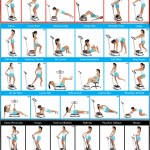
Whole Body Vibration System
While the use of vibration therapy and training is a still relatively new concept to most health and fitness and medical professionals, it certainly does not suffer from lack of supportive research, and while there is obviously much research yet to be done in the area, the overwhelming consistency of findings from scientific research that currently exists on the subject is a compelling precursor to the vibe’s potential applications and impact on this revolutionary method of training and treatment.
Muscles
The effect of vibration results in what scientific literature calls ‘Tonic Vibration Reflex’ or ‘TVR’. That is a repeated myotatic reflex or stretch reflex. This means that the vibrated muscle has to work very hard, while the subject or player using the vibe does nothing other than balance on the platform. The effect per pulsation is like that of the knee jerk reflex. This muscle activity can be measured by use of electromyography (EMG). For example, in a one repetition maximum effort, the muscle(s) involved are activated 100% voluntarily. However with vibration training on the vibe the muscles work at 200 to 300% of this IRM activation. This is an ideal way to train, especially when the muscle does not function properly, for example with weakened muscles in the elderly, or after injuries.
Hormones
Research shows that after vibration training (just one session!), there is a high excretion of Testosterone and Growth Hormone. There is also a drop in the stress hormone cortisol. This combination has favorable effects on muscle protein synthesis.
Increases in Testosterone and Growth Hormone are important in the functioning of both body and mind. Many complaints of the elderly can be traced to a decrease in these hormones. It is essentially these hormones, together with the female hormone estrogen, which are used to combat geriatric complaints so that it is possible to still enjoy life and vitality even when one has reached old age.
Bones
Bone decalcification (osteoporosis) is one of the biggest health problems especially in the elderly and women population. Many elderly people break their bones more easily when they fall because of bone decalcification; the hip is the most notorious in this respect. The onset of osteoporosis is partly due to a lack of movement, which causes muscles to gradually weaken, the circulation to diminish and the bones to be inadequately used. In addition, as a result of the ageing process, the body produces less hormones such as testosterone, estrogen and growth hormone. Yet it is exactly these hormones which play such an important role in the maintenance of strong bones.
The advice usually given to sufferers of this disease is to take more exercise, but that is difficult when muscles are weak, particularly in the legs. the vibe offers a good alternative to vigorous impact exercise: through vibration the muscles automatically become stronger and regain their tone. The circulation improves because the blood vessels in the legs are wide open due to the vibration. At the same time, the pulsation gives a direct stimulus to bone tissue, which in turn stimulates the production of new bone tissue.
Scientific research shows that vibration training can help against osteoporosis. Recent findings show that even after only one vibration treatment, there is an increase in the hormone testosterone and growth hormone, which are so essential for strong bones.
Neurotransmitters
Parkinson’s disease is an example of a deficiency in dopamine, which is the reason that L-Dopa is given as medicine. It is also recognized that serotonin plays a role in our mood, or frame of mind. A shortage of serotonin in the brain can lead to depression, which is the reason that Prozac is given as a medicine in order to increase the serotonin content in the brain. From research, it appears that vibration training also influences the neurotransmitters and the way in which they work. Vibration training increases the serotonin content in the brain, which could possibly explain why one feels so well after vibration training.
Blood Vessels
The effect of vibration training on the blood vessels is clear to see and to feel. After training, one often sees that the skin of the lower leg is colored pink. This is a sign that the blood vessels in that area are wide open. It also explains the feeling which many describe as coming home after a snowball fight with your bare hands, and then putting your hands in a bucket of warm water. A tingling feeling which indicates that your blood vessels are wide open. In Germany, the effect of vibration training is used as therapy for a disturbed peripheral circulation, particularly in the lower legs, such as in chronic venous insufficiency.
Nervous System
The effect on the muscles is reflexively activated via the nervous system. With vibration training, it seems as if pulsations awaken the nerve tract, which could explain the positive effects of vibration training in partial paralysis. In fact, good results have been reported in the experimental treatment of, for example, MS patients.
Video
Exercises
View the many different exercises you can do with the whole body vibration therapy.

